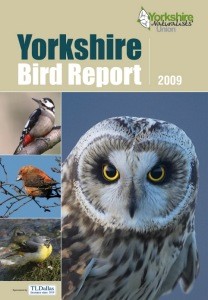Yorkshire Naturalists’ Union Bird Report for 2009

The Report for 2009 continues with the tradition of invaluable information, presented in over 208 pages with 28 colour plates. Craig Thomas has taken on the editor's role for the fourth year, ably assisted by Jill Warwick. 289 Category A species accounts are included with no new birds for the County List (the Tophill Low Amur Falcon (Falco amurensis) has been admitted for 2008). The usual Category B and E sections can be found at the back. The County's Adjudication Panel considered 107 records, of which only 15 were rejected. The reader's appetite is whetted by highlights including Green-winged Teal, Bean Goose, Rough-legged Buzzard, Great White Egret, Caspian Gull, Common Crane, Montagu's Harrier, Subalpine Warbler and Cetti's Warbler.
Yorkshire is a big place, the largest county in the UK, covering almost 12,000 square km. Habitats range from grouse moor, high fells and Pennine dales (valleys) to lowland heath, farmland, chalk wolds and of course the coast. Early birdwatching in Yorkshire centred on the coast, and no wonder with the spectacular seabird colonies at Bempton and to a lesser extent Flamborough. Fans of scarce and rare migrants are well served by Spurn, Filey Brigg and Flamborough; the last location became the centre for advanced seawatching in the 1970s when it became the place to see shearwaters and skuas in the autumn.
County and local bird reports serve several important roles, as a historical record of the avifauna preserved and made available for future research and comparison. The changing fortunes of different bird populations, particularly in these times of climate change, habitat destruction and human interference, are instructive. Diurnal raptors offer an example: successes include the Harewood Red Kite introduction programme just twelve years ago, with 117 known young raised in the county in 2009, and the remarkable range expansion of the Common Buzzard, but sadly the Hen Harrier population is in a parlous state on our grouse moors.
I believe that fledgling birdwatchers should be encouraged to take an interest in their local and county reports as soon as possible in their careers. Bird identification is often a process of elimination: should it be here at this time of year? Does it normally occur in the area? What sort of habitat does it prefer? These questions can often be resolved by reference to a report. For me it's as logical as using field guides and handbooks sensibly.
In conclusion, back to the 2009 Report. My favourite photos are a quirky Firecrest by Ian Smith, a gorgeous Wood Warbler by Dave Mansell and a full-page reproduction of a Great Grey Shrike by Steve Race. Newcomers to Yorkshire Ornithology or, for that matter, bird reports in general will be surprised by the Aladdin's Cave of goodies to be found in this publication. Compilation of reports is not a task to be envied and I salute those who accept it. I have a little experience of report writing — it's hard work!
Published by The Yorkshire Naturalists’ Union, 208 pages, 28 colour plates, £10.00 plus £2.00 post & packing. Available from Jill Warwick. jill@swland.co.uk, (01765) 602832.


